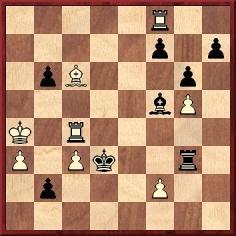Chess
Notes
|
| First column | << previous | Archives [59] | next >> | Current column |
6151. What did Black play?
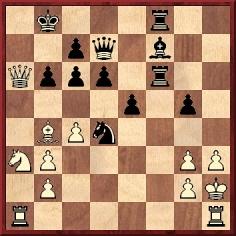
6152. Q.M. Hussain
Manuel Aaron (Chennai, India) informs us that for a book on Indian chess history he is seeking information about Professor Q.M. Hussain M.A., Ph.D., who was active in the game in the 1930s. In Bangladesh there exists a memorial chess tournament held in his name.
He was the Director of the Institute of Statistical Research and Training in the University of Dacca (now Dhaka, in Bangladesh), and his full name may have been Quazi Motahar Hussain. His estimated date of birth is 1897.
6153. Lasker v Capablanca tenth
match-game
Frederick S. Rhine (Park Ridge, IL, USA) notes that on page 61 of our Capablanca chapter in World Chess Champions (Oxford, 1981) we wrote regarding the 1921 match for the world crown:
‘Despite the valiant efforts of the man who had held the title for 27 years, the Cuban could, and did, claim that, far from losing a game in the whole match, not once had he actually been in a markedly inferior position.’
However, Capablanca’s notes to the tenth game, given on pages 59-60, included an observation that in this position (after his 16th move, ...Nb6-d5) ...
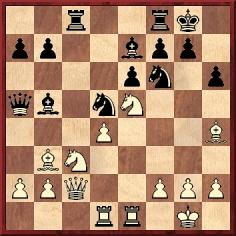
... the line 17 Bxf6 Bxf6 18 Bxd5 exd5 19 Qf5 would have left him ‘with a very hard game to defend’.
Given that ‘a markedly inferior position’ is more or less synonymous with ‘a very hard game to defend’, Mr Rhine wonders to what extent there is a contradiction between our statement and Capablanca’s note. We are grateful to him for raising an interesting matter and offer below some non-exhaustive jottings:
1) Capablanca wrote on page 376 of the October 1922 BCM (in his reply to Lasker):
‘The one outstanding feature of the match and the one that most critics overlook is that not once did he have a won game. A feat to be very proud of, as up to the present it is unique in the annals of championship matches.’
On other occasions the Cuban may have phrased the claim differently, but the above is its most prominent occurrence.
2) The annotations in which Capablanca stated that the 17 Bxf6 line would have left him ‘with a very hard game to defend’ were published over a dozen years later, on page 210 of A Primer of Chess (London, 1935):
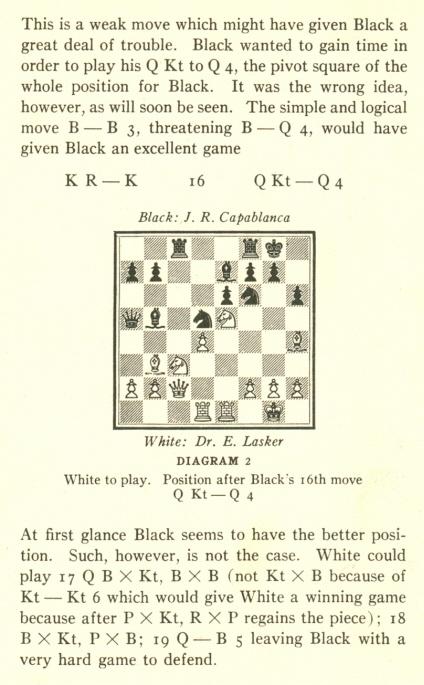
3) In his match book (published in New York in 1921) Capablanca made no comment on moves 16-18. He merely stated after 15...Bb5:
‘With this move and the following, Black brings about an exchange of pieces, which leaves him with a free game.’
This stands in contrast with his remark in A Primer of Chess (shown in the illustration above) that 15...Bb5 was ‘a weak move which might have given Black a great deal of trouble’.
Thus Capablanca’s initial (1921) assessment of the play around moves 15-17 changed considerably later on.
4) That phase of the game became the subject of close examination, as is shown by the following:
- G. Breyer: chess column in Bécsi Magyar Újság, 11 May and 18 June 1921. We have not seen the original columns, but the analysis was reproduced, in Hungarian, on pages 276-277 of volume three of Magyar Sakktörténet (Budapest, 1989). A German version appeared on pages 140-142 of Gyula Breyer Sein Leben, Werk und Schaffen für die Erneuerung des Schachs by Iván Bottlik (Unterhaching, 1999).
- Emanuel Lasker gave the 17 Bxf6 line on page 23 of his booklet Mein Wettkampf mit Capablanca (Berlin and Leipzig, 1922), mentioning the late G. Breyer:
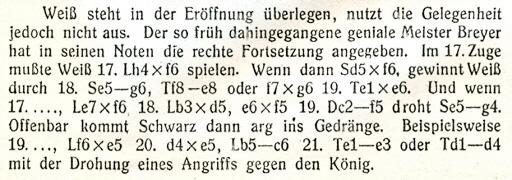
- E. Bogoljubow: pages 210-211 of his book Izbrannyye partii (Moscow, 1926):
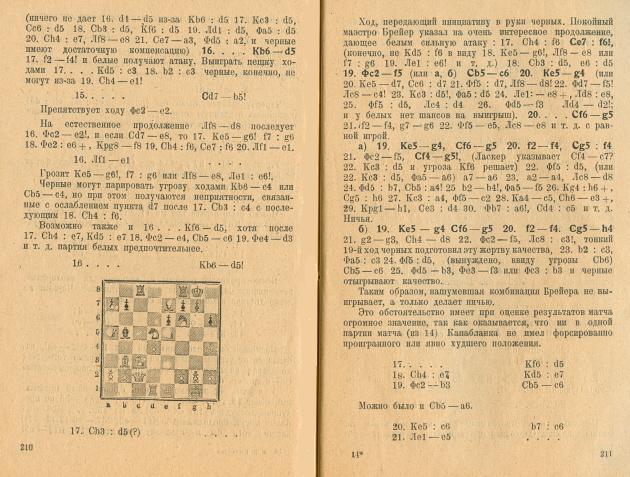
- F. Reinfeld: pages 99-100 of The Immortal Games of Capablanca (New York, 1942). The analytical note to Black’s 16th move began:
‘Here is the famous position which has appeared all over the world because of Breyer’s sensational analysis giving White the better game. Bogoljubow has subjected this analysis to searching scrutiny, however, and shown that Black can still escape with an even game.’
- H. Golombek: pages 80-81 of Capablanca’s Hundred Best Games of Chess (London, 1947). A detailed analytical note, referring to Breyer, which Golombek concluded as follows:
‘Apart from its intrinsic interest, this analysis is of considerable importance in substantiating the claim that at no stage in his match with Lasker did Capablanca ever obtain a really inferior position.’
- G. Abrahams: pages 249-250 of The Chess Mind (London, 1951). The analysis (referring to Breyer) concluded with this remark by Abrahams:
‘The position at move 17 may justly be said to be one of the great historic occasions of chess. Had Lasker avoided loss, the course of chess history would have been very different.’
- W. Winter: page 93 of Kings of Chess (London, 1954):
‘It is unique among championship matches in that the winner never seemed to have a lost position. That was Capablanca’s own considered view, and subsequent analysis has done nothing to shake it.’
- C.J.S. Purdy: Chess World, January 1954,
pages 15-17, and April 1954, pages 85-88. Only the
first article was given in The Search for Chess
Perfection by Purdy (Davenport, 1997). See pages
166-168.
- I. Chernev: Capablanca’s Best Chess Endings (Oxford, 1976), page 125:
‘Breyer proposed the illogical-looking 17 Bxf6 as offering White winning chances, but Bogoljubow’s analysis showed that Black had a draw in all variations, and vindicated Capablanca’s claim of never having been in a losing position in his match with Lasker.’
- ‘Garry Kasparov on My Great Predecessors Part I with the participation of Dmitry Plisetsky’ (London, 2003), page 270. Some analysis, referring to Breyer and Bogoljubow.
We hope that a master analyst will go into the matter in depth, so that it can be established exactly how strong Lasker’s winning chances would have been after 17 Bxf6.
6154. Prague, 1931
Jan Kalendovský (Brno, Czech Republic) has sent us page 5 of the 2 August 1931 issue of Wiener Bilder, and the chess part is reproduced below:

The caption on the right correctly names the line-up of the victorious US team in the Prague Olympiad but identifies the woman as Vera Menchik. Who was she really?
6155. Grandmaster title (C.N. 6146)
C.N. 6146 asked about the ‘highest age at which anyone has gained the grandmaster title for over-the-board play in regular fashion (and not, for instance, honoris causa)’.
Andrew Bull (Cheltenham, England) mentions that the subject was discussed in Tim Krabbé’s ‘Open Chess Diary’ (item 193), where it was noted that Jānis Klovāns became a grandmaster in 1997, aged 62, by winning the senior world championship. Our correspondent adds:
‘If this does not count as gaining the title in regular fashion, another name suggested was Valery Grechihin, who became a grandmaster in 1998 aged 60.’
6156. Who?
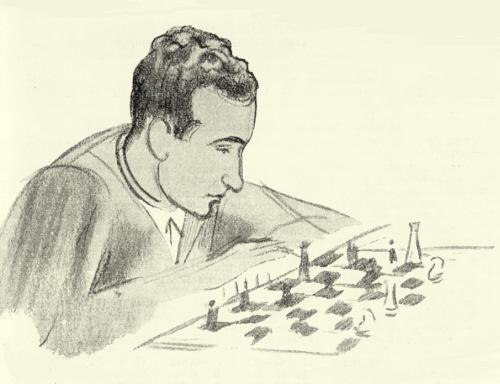
Identifying this well-known master is no mean feat.
6157. Mate in three
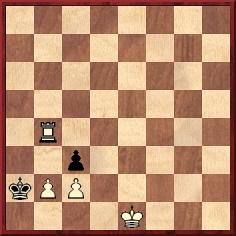
This problem has been presented in chess literature as a mate in three, but is it?
6158. ‘Trio of famous composers’
From page 267 of the December 1918 American Chess Bulletin:
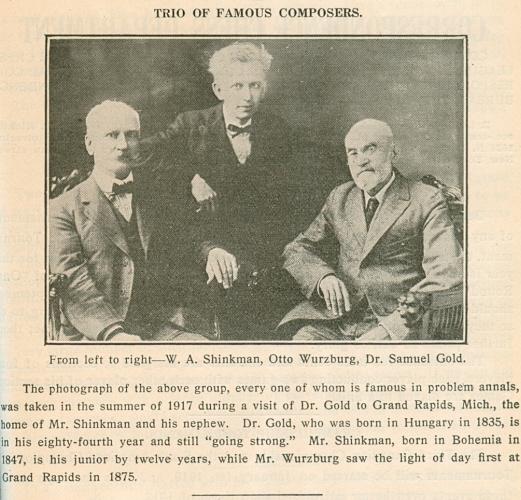
6159. Mate in one missed?
A claim by George Koltanowski on pages 8-9 of Your Chess Companion for 1940 edited by John N. Buck (Lynchburg, 1939):
‘Dr Ticolat arrived at a position in which he could mate Dr Rey in one move. But Dr Ticolat started to study (with a very red face). Time passed; we thought he had fallen asleep – but no, at long last he moved, and believe it or not, he managed to lose! Of course, though, this could happen to anyone.’
Ticolat should read Ticoulat, but on what grounds did Koltanowski relate the story? The game in question (R. Rey Ardid v N. Ticoulat, Sitges, 1934) went as follows: 1 d4 d5 2 c4 e6 3 Nc3 Nf6 4 Bg5 Nbd7 5 e3 c6 6 cxd5 exd5 7 Bd3 Be7 8 Qc2 O-O 9 Nge2 Re8 10 h3 Nf8 11 O-O-O b5 12 Kb1 a5 13 Rc1 a4 14 Nd1 Bd7 15 Bf5 Bxf5 16 Qxf5 Rc8 17 Nf4 Ne4 18 Bxe7 Rxe7 19 Nxd5 Re6 20 Nf4 Re7 21 Nd3 Nd2+ 22 Kc2 Nc4 23 Nc5 Ne6 24 Nxe6 Rxe6 25 Qc5 Qf6 26 Qh5 c5 27 Kb1 cxd4 28 Ka1 Rec6 29 Qxb5 a3 30 b3 Ne5 31 Rxc6 Nxc6 32 Qc4 g6 33 exd4 Qxd4+ 34 Qxd4 Nxd4 35 Ne3 f6 36 Kb1 Nb5 37 Rc1 Rxc1+ 38 Kxc1 Nc3 39 Nc4 Nxa2+ 40 Kd2 Nb4 41 Nxa3 Nd5 42 g3 Kf7 43 Kd3 Ke6 44 Kd4 Kd6 45 Nc4+ Ke6 46 Kc5 f5 47 b4 g5 48 b5 f4 49 b6 fxg3 50 b7 g2 51 b8(Q) g1(Q) 52 Qe5+ Kf7 53 Qxd5+ Kg6 54 Ne5+ Kf6 55 Kd6 g4 56 Qf7+ Resigns.
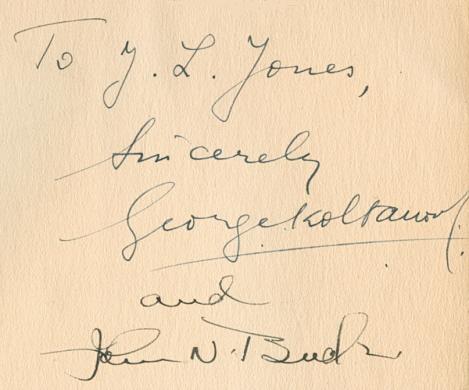
Inscriptions by Koltanowski and Buck in our copy of Your Chess Companion for 1940
6160. Koltanowski’s reportage
C.N. 4191 quoted two snippets from an ‘article’ by Koltanowski on page 412 of the 14 July 1936 issue of CHESS. Below in all its splendour is the whole thing:
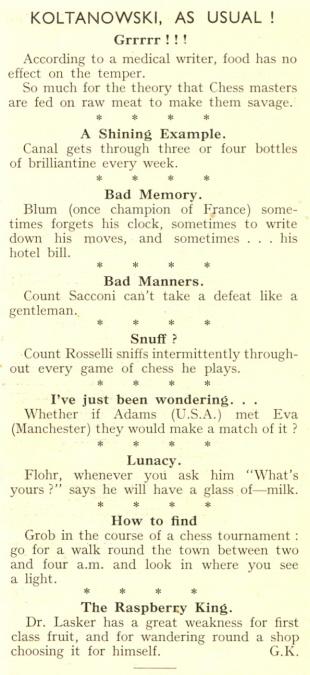
6161. Counter-counter-pin
We wonder whether Irving Chernev was the first writer to use the term ‘counter-counter-pin’, on page 63 of Combinations The Heart of Chess (New York, 1960). He was discussing a variation in the game Boleslavsky v Bisguier, Helsinki Olympiad, 1952:
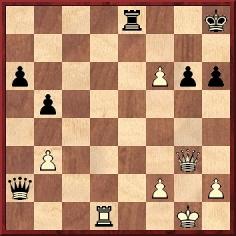
‘White moved 1 Q-B7 and eventually won. Had he played 1 QxP instead, to allow a pin and then break it with a counter-pin, he would have been trapped by a counter-counter-pin.’
The line in question, 34 Qxg6 Rg8 35 Rd8 Qb1+, had been given by Boleslavsky on page 188 of his book Izbrannyye partii (Moscow, 1957); see also page 164 of the English edition, Selected Games edited and translated by Jimmy Adams (London, 1988). Boleslavsky furthermore suggested that 34 f7, rather than 34 Qc7, would have won more quickly, but readers armed with a strong computer program will make interesting discoveries.
6162. Alekhine’s last tournament book
In connection with the new algebraic edition of the Nottingham, 1936 volume (Milford, 2009) Hassan Roger Sadeghi (Lausanne, Switzerland) notes the misconception that it was Alekhine’s last tournament book; a volume on Madrid, 1943 is sometimes overlooked.
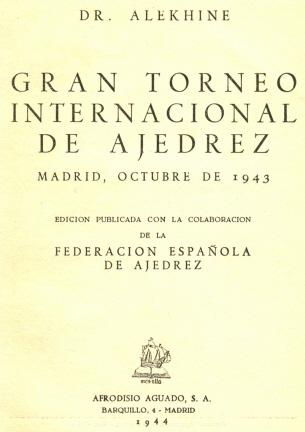
Gran torneo internacional de ajedrez differed
from Alekhine’s other tournament books in that the 105
games were unannotated, although each had an
introductory paragraph. Two sample pages are shown
below:
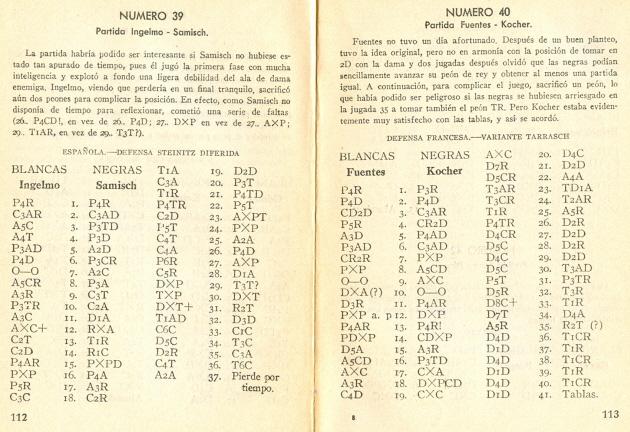
6163. J.N. Derbyshire
The Nottingham, 1936 tournament book was dedicated to Alderman Job Nightingale Derbyshire (1866-1954), an exceptional chess patron who was the key figure behind the event. Below are two portraits of him:
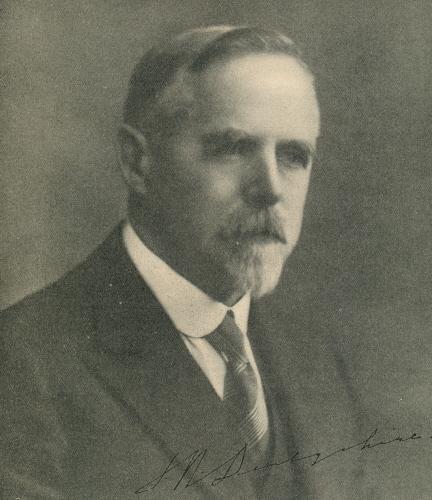
J.N. Derbyshire (CHESS,
14 September 1936, page 9)
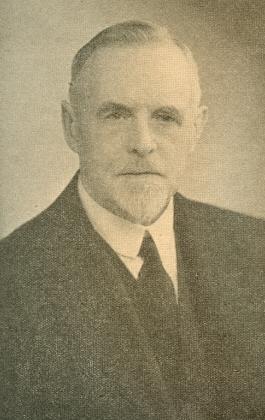
J.N. Derbyshire (British Chess Federation Year Book 1938-1945, page 2)
6164. Selenus, Shakespeare and Bacon
Michael Clapham (Ipswich, England) refers to a catalogue of chess books issued in 1937 by the University Place Book Shop, New York. Below is an extract from the entry regarding Das Schach oder Koenig-Spiel by Gustavus Selenus (Leipzig, 1616), which was offered for $60:
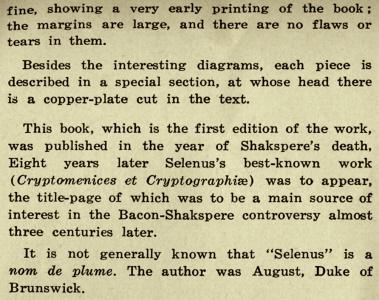
Our correspondent also draws attention to a discussion of the Shakespeare/Bacon matter in connection with the above-mentioned title-page.
6165. Fine’s challenge
Frederick S. Rhine (Park Ridge, IL, USA) points out a letter written by Reuben Fine which was reproduced on page 260 of David DeLucia’s Chess Library A Few Old Friends (Darien, 2007). Dated 27 November 1972 and addressed to Norval Wigginton of Bethesda, MD, Fine’s letter reads (last paragraph):
‘I’ve challenged Bobby to a match for the title for a purse of $1 million, which I think could be raised if he would agree to play. But he hasn’t replied to my letter. Maybe you could get a committee together to see whether it could be done.’
Is anything more known about the challenge? The following appeared as a footnote on page 54 of Bobby Fischer’s Conquest of the World’s Chess Championship by ‘Reuben Fine, Ph.D., International Chess Champion’ (New York, 1973):
‘A Las Vegas hotel reportedly offered $1.4 million for a return match with Spassky which Fischer refused, demanding $10 million. I have also challenged Fischer to a match for a purse of $1 million. Some are now openly wondering whether Fischer will ever play again.’
In a review of Fine’s book on page 396 of the June 1974 Chess Life & Review Anthony Saidy referred to ‘Fine’s rather pathetic “$1 million” challenge to Bobby’. On page 467 of the July 1974 issue ‘A Reply from Reuben Fine’ did not comment on that point.
6166. Who? (C.N. 6156)
The illustration appeared on page 145 of CHESS, 28 January 1956:
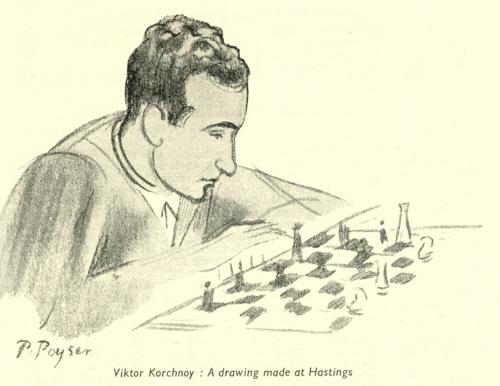
6167. Rudolf Hess
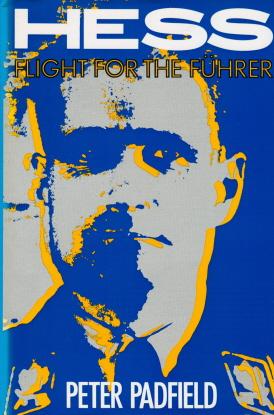
Santhosh Matthew Paul (Ernakulam, Cochin, India) quotes from page 7 of Hess Flight for the Führer by Peter Padfield (London, 1991):
‘Returning to the front with the 1st Company of the 1st Foot in November, he was engaged in more trench warfare in the Artois sector, and early the following year, 1916, took part in the battles for Neuville St Vaast. Then, struck by a throat infection in February, he spent most of March and April in various hospitals with acute laryngal catarrh. Years later he could recall his pleasure as the only patient at St Quentin to beat a Berlin chess master who took on 12 opponents at once. He had been introduced to the game by his mother when he was 12 while he and his brother, Alfred, had been in quarantine for scarlet fever.’
Page 353 stated that the source of the information about the simultaneous display was a letter from Hess to his wife, Ilse, in December 1947.
Can any further information be found concerning Rudolf Hess and chess?
6168. Marshall’s announcement of retirement
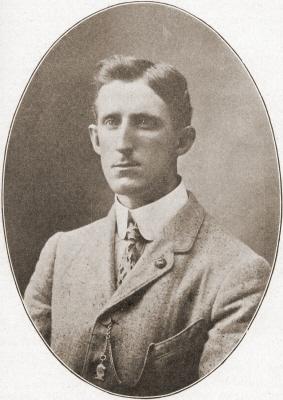
Frank James Marshall
C.N. 48 (see page 105 of Chess Explorations) mentioned a surprising report on page 12 of the Daily Sketch (London) of 23 December 1909 that Frank Marshall was retiring from chess. Below is the full text:
‘After a career extending over 21 years, Frank J. Marshall, the famous American chessplayer, has retired from the game. He retires with the title of champion chessplayer of America, which distinction he won recently from J.W. Showalter in Louisville.
Marshall’s defeated opponent received the title at the decease of Pillsbury, who in turn won it from him. Showalter received the title because of the fact that he had made the best showing against Pillsbury of all the claimants to the title. Marshall won the title from Showalter after four games, three of which were drawn and the fourth being a victory for him by the score of 7 to 2.
Marshall’s genius for the game was hereditary, for his father’s folk before him were all “sharks” at the game. When a boy Marshall devoted all his time to chess. When he was nine years of age his (Marshall’s) parents moved to Montreal from New York City, where Frank was born, and remained until he was 17 years old. They then moved to Brooklyn, and still reside in that borough.
Frank won his first title at the age of 15 years, when he became champion of Montreal. Since that time many other titles have been won by him, and although while in Europe he was billed as the champion of America the title was actually won by him recently in Kentucky.
Marshall’s retirement is due to two reasons – his wife and his business. The former seems to be the greater cause, for she claims that her husband should devote his time to her and to their little son, Frank Rice Marshall.
When asked for his reasons for retirement Marshall said: “The game is too absorbing. To play it one must devote to it all of his time. No game in the world calls for such deep study and devotion as chess, and while I love it there are other things which must occupy my attention. I have private business responsibilities which suffer from the game, so I decided to quit playing for good.”’
We refrain from commenting on the content of that report, but what are its origins? A brief announcement had appeared in the New York Times of 28 November 1909 (sporting news section, page S1):
‘Lexington, Ky., Nov. 27. – Frank J. Marshall of New York City, who yesterday won the chess championship of the United States over J.W. Showalter of Georgetown, Ky, authorizes the statement that he has quit the chess game for good and that he will give his attention to his business interests. He made this statement here today, upon coming from Georgetown, where his series with Mr Showalter ended last night.
Mr Marshall has been in every chess tournament of the past ten years and holds, besides the championship of this country, the Salta championship of the world. He has in his possession a prize Salta board, presented to him by the Emperor of Germany and the Prince of Morocco [sic] in 1906, when he won the world’s championship.’
6169. H.J.R. Murray
Christopher Lenard (Bendigo, Victoria, Australia) reports that the biography of James A.H. Murray Caught in the Web of Words by K.M. Elisabeth Murray (Oxford, 1977) has on page 316 a photograph which includes H.J.R. Murray (her father):
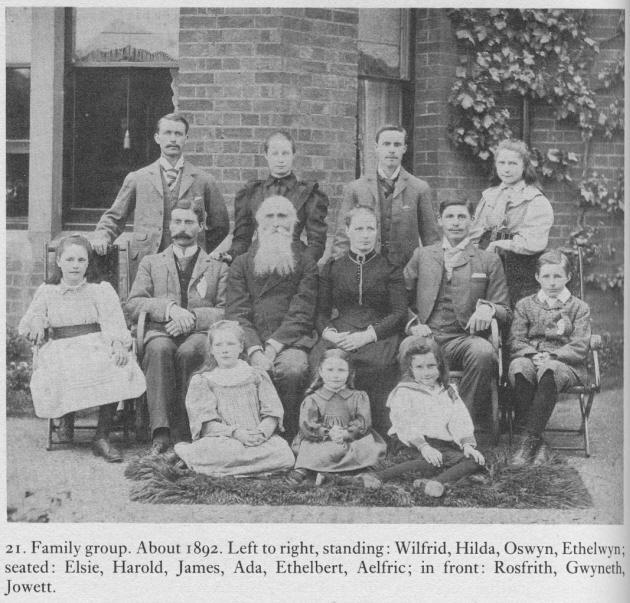
6170. Anti-blindfold
From R.J. Buckley’s chess column in the Birmingham Weekly Mercury, 25 August 1906, page 3:
‘What has the sensational exhibition to do with beautiful chess?
Why this craving for the red fire, the jugglery, the purposeless mental acrobatism that was fatal to Pillsbury? The desire for such exhibitions denotes a low level of intelligence.
Why should civilized chess amateurs exhibit the tastes of the bricklayer’s hodman or the British farm labourer?
Let the blindfold business die with poor Pillsbury. If another great chess master should arise in America, let him not be “butchered to make a gobe-mouche holiday”.’
6171. Capablanca interview
Christian Sánchez (Rosario, Argentina) points out an interview with Capablanca by Adelardo Fernández Arias in ABC on 12 May 1932.
Many of the standard interview topics were covered. In particular, the Cuban complained about being unable to obtain a rematch with Alekhine and said that FIDE was not strong enough to run the world championship. He was sure that he could regain the title, and especially if Alekhine lost in the early games, which would demoralize him. Capablanca evoked race and climate when stating that Slavs were the best chessplayers. He also commented that he had earned more money from chess than anyone else, although the sums to be derived from the game were not high. He believed that chess should be taught in schools to help children organize their thoughts and, regarding actual play, expressed a particular liking for pawns. Asked about women players, Capablanca named only Vera Menchik, whom he described as ‘very strong’. On the subject of important games, as a curiosity he referred to a simultaneous display in Moscow in 1925 at which the People’s Commissars Rykov and Krylenko were present. He added that Trotsky was a good player, as Lenin had been. Among chessplaying celebrities, he mentioned the pianist Rosenthal.
6172. A famous Capablanca quote
‘I know at sight what a position contains. What could happen? What is going to happen? You figure it out. I know it!’
The full context of this quote was supplied on pages 85-86 of our book on Capablanca: it appeared in an article by Howard L. Dolde in the Pittsburgh newspaper the Gazette Times and was reproduced on page 99 of the May-June 1916 issue of the American Chess Bulletin. The occasion was a simultaneous display in Pittsburgh (the Cuban’s score being +51 –0 =1) on 3 May 1916.
Now we are able to add the exact reference regarding Dolde’s column: the Pittsburgh Gazette Times of 7 May 1916, sixth section, page 8.
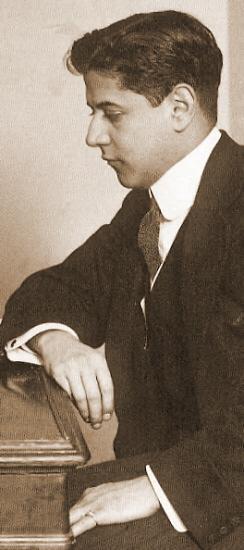
José Raúl Capablanca
6173. Rudolf Hess (C.N. 6167)
Lawrence Totaro (Las Vegas, NV, USA) draws attention to an article ‘When I played chess with Rudolf Hess’ in the Evening Chronicle (Newcastle) of 24 November 2007. Maurice Williams reported that he had played against Hess when on guard duty at Spandau Prison in 1951.
6174. Who?
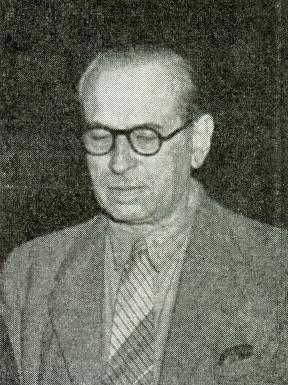
6175. The Rubinstein rule
Jonathan Berry (Nanaimo, BC, Canada) asks about the origins of the rule that the game is forfeited by a player who does not come to the board during the first hour of the playing session. Our correspondent believes that this has been termed the ‘Rubinstein rule’, but can any connection with Akiba Rubinstein be established?
6176. What did Black play? (C.N. 6151)

In such a quiz position it is tempting to suggest a spectacular coup (...Qxh3+), but the game had a quiet move first: 21...Be8 22 Nb5 and only then the queen sacrifice. The play was taken from page 46 of the Chess Amateur, November 1915:
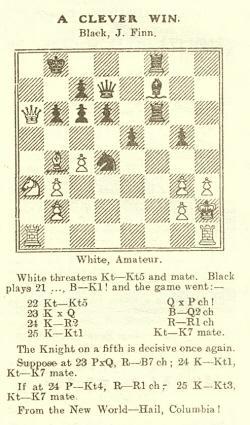
Olimpiu G. Urcan (Singapore) adds:
‘The finish had appeared in volume one of Jacob Halpern’s book Chess Symposium (New York, 1904). On page 155 he gave the sequence 1...Be8 2 Nb5 Qxh3+ 3 Kxh3 Bd7+ 4 Kh2 Rh8+ 5 Kg1 Ne2 mate and added the same secondary lines as in the Chess Amateur: 3 gxh3 Rf2+ 4 Kg1 Ne2 mate and 4 g4 (after 1...Be8 2 Nb5 Qxh3+ 3 Kxh3 Bd7+) 4...Rh8+ 5 Kg3 Ne2 mate.
Halpern did not specify the occasion, merely introducing the position with “Mr J. Finn played the following most interesting endgame against an amateur”.’
[Addition on 11 July 2009: Mr Urcan subsequently noted that the Halpern book was published in 1902, not 1904. See C.N. 6209.]
Julius Finn is on the left in the photograph below, which was published opposite page 110 of Glorias del Tablero “Capablanca” by José A. Gelabert (Havana, 1923):
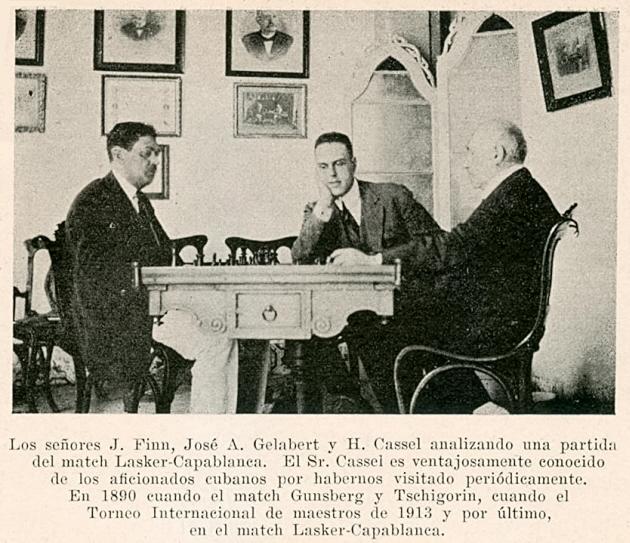
6177.
Three-mover by Lasker
A sketch from page 9 of the Daily Mail, 6 October 1906, which accompanied the article by James Mortimer with the ‘rabbit quote’ (C.N. 6122):
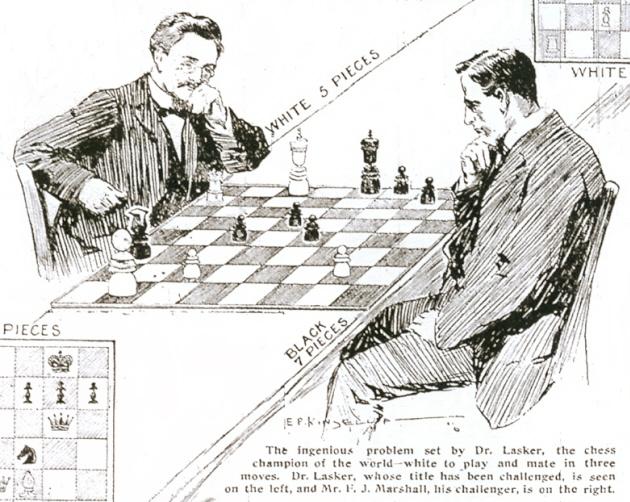
6178. The Rubinstein rule (C.N. 6175)
Stephen Wright (Vancouver, Canada) quotes from page 36 of Chess Canada, September-October 1974, in an article by Bent Larsen entitled ‘Blame it on the Computers’:
‘Rubinstein did not like the public, and in some of his last tournaments he preferred to arrive very late and play quickly, which is the reason for the one hour rule we have now.’
From Robert John McCrary (Columbia, SC, USA):
‘The earliest example of the provision forfeiting a player for arriving one hour late at the board is in the additional rules of the Fourth American Chess Congress (Philadelphia, 1876). Page viii of the tournament book gives that rule, which was added by the players to the original rules, as follows:
“A player coming in one hour after the commencement of the sitting will forfeit the game, subject, however, to an appeal to the committee, who, if his excuse be valid, may decide otherwise.”
A “sitting” referred to each of three segments of four or four-and-a-half hours in one game (allowing for meal breaks), so that a player might forfeit for arriving an hour late to resume a game already in progress after a break.
The first instance of the modern rule that I have seen is rule 12 on page xii of the London, 1883 tournament book. It states that a player arriving late for a game or after the adjournment will have have his clock started, and will forfeit if one hour late; or earlier if he exceeds his 15 moves per hour time-limit after the adjournment even if before the hour. The rule specifies that both players lose if they are both an hour late.
For the period before 1876 I have found only more lenient rules, usually allowing solely for fines for late players. However, at London, 1862 there was a forfeit after five hours, following a grace period of one hour, plus two full time-control periods at 20 moves in two hours. The actual rule, on page lii of the tournament book, concludes:
“In any case he must complete 40 moves within four hours of his glass being set running. Should he not make his appearance within five hours of the time appointed, he shall forfeit the game.”
However, the next rule excludes double-forfeits, saying that the players will be merely fined if both are five hours late. (Players set their own game times by agreement.)’
6179. Jacob Billikopf
Further to our comments about Jacob Billikopf on page 130 of Kings, Commoners and Knaves and in the Chess Prodigies feature article, below is the item published on page 335 of the November 1897 American Chess Magazine:
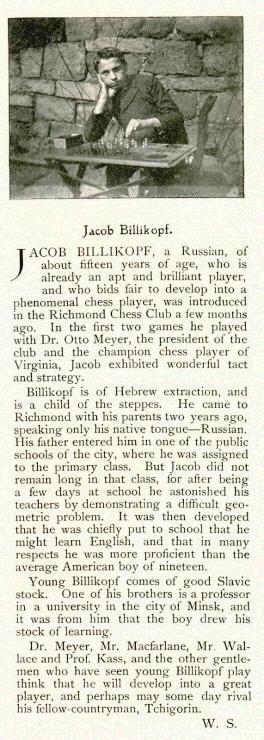
Diego Monteiro de Oliveira (Curitiba, Brazil) and Jim
Thompson (Jefferson, NC, USA) identify him as the social
worker
and
leader
in Jewish philanthropy who was also a prominent
figure in labour arbitration.
His obituary on page 17 of the 1 January 1951 issue of the New York Times stated that he was born in Vilnius on 1 June 1883 and died in Philadelphia on 31 December 1950.
6180. Isaac Kashdan and Groucho Marx
Concerning Isaac Kashdan’s appearance on the television show You Bet Your Life, presented by Groucho Marx, Gene Gnandt (Houston, TX, USA) points out that the segment can be viewed on YouTube. It is also available on a ‘14 Classic Episodes’ DVD.
[Addition on 6 May 2011: the YouTube link no longer works, but C.N. 7072 gives a replacement link.]
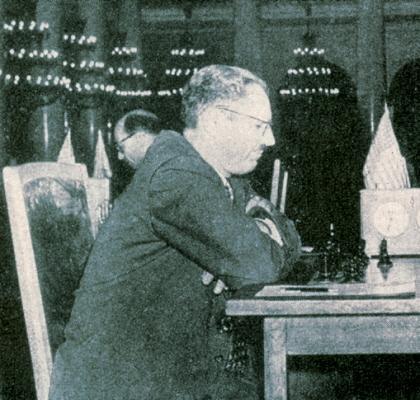
Isaac Kashdan
6181. Small magazines (C.N. 6132)
Richard Forster (Zurich) notes a magazine whose format is smaller than the two shown in C.N. 6132:
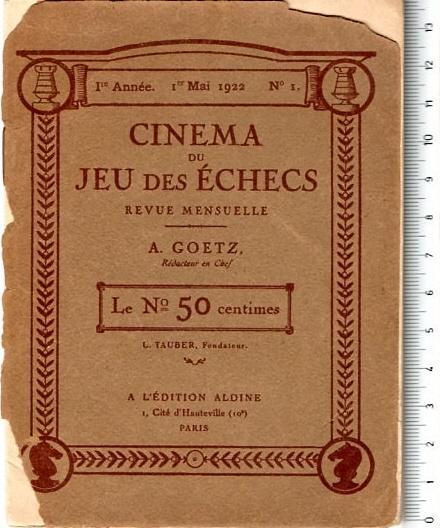
6182. Lasker v Capablanca tenth match-game (C.N. 6153)
We add the relevant part of the annotations by Bogoljubow on pages 60-61 of volume two of his work Klassische Schachpartien (Berlin and Leipzig, 1926):
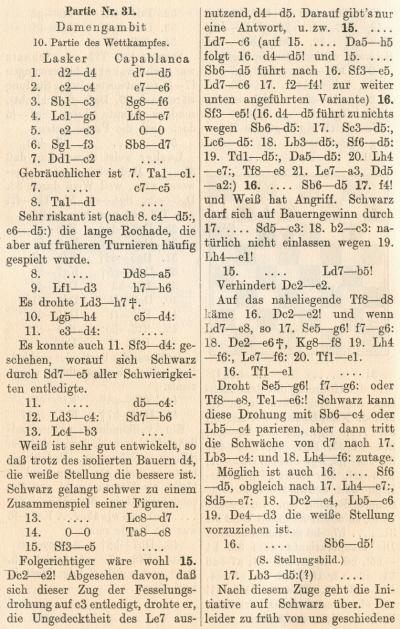
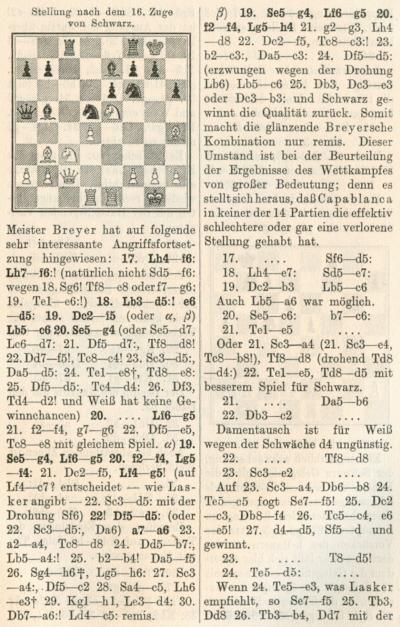
6183. Counter-counter-pin (C.N. 6161)
From Michael McDowell (Westcliff-on-sea, England):
‘Chernev’s term strikes me as ill-conceived, as counter-counter-pin implies three pins altogether. I was reminded of the following study (by A. Troitzky and V. Korolkov; second Honourable Mention, Shakhmaty v SSSR, 1938) quoted on page 91 of Harold Lommer’s book 1357 End-Game Studies (London, 1975):
White to move and win
1 Rb4 Rh4 2 c4 Rxc4 3 Bb5 Bd7 4 Rd8 wins.
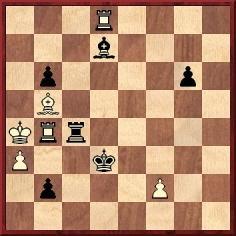
If 4…b1(Q) 5 Rxd7+ Ke4 6 Bxc4.
Harold van der Heijden’s database gives 1…Kxc3 as a refutation, and an alternative version with the black rook on h3 rather than h5. Is this latter setting sound? The study is not included in the 1958 and 1998 collections of Korolkov’s work.
The study below (by André Chéron, published in the Journal de Genève, 23 February 1974 and dedicated to Harold Lommer) is given on page 152 of Chéron’s book Le joueur d’échecs au pays des merveilles. The van der Heijden database has the f8 rook on a8. Is the database position Chéron’s original setting and the 1982 setting an amendment as a result of unsoundness? Is either setting sound?
White to move and win
1 Rb4 Rg4 2 c4 Rxc4 3 Bb5 Bd7 4 Rd8 b1(Q) 5 Rxd7+ Ke4 6 Bxc4 Qa1 or …Qc1
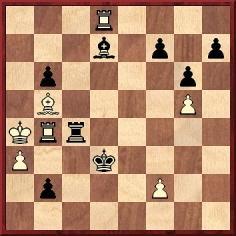
7 Bd3+ Kf3 8 Rxf7+ Kg2 9 Rg4+ Kh3 10 Rg3+ and 11 Rxh7 mate.’
6184.
Rosenthal
In the interview presented in C.N. 6171 Capablanca referred to the pianist Moriz Rosenthal as a chessplaying celebrity, and below is a photograph of him taken in the 1930s:
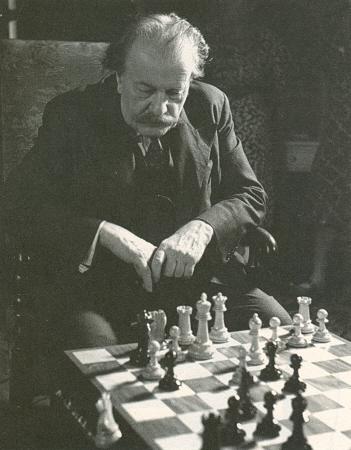
Source: page 82 of Moriz Rosenthal in Word and Music edited by M. Mitchell and A. Evans (Bloomington, 2006), courtesy of Musical America.
6185. Alexander v Botvinnik
From page 102 of the 4/2009 New in Chess (in an article by Hans Ree):
‘... I was reminded of a remark about Botvinnik that is attributed to C.H.O’D. Alexander: “When he wrote down 1 c2-c4 against me I felt like resigning.” By the way, Botvinnik never played 1 c4 against Alexander (against me he did), so this might seem an instance of the threat being stronger than the execution, but only if you believe the impossible: that Botvinnik would ever write down a move that he was not going to play.’
This episode was discussed briefly in C.N. 4292, where Alexander’s exact words were quoted, from page 16 of A Book of Chess (London, 1973):

Reviewing the work on page 63 of the February 1974 BCM (the month Alexander died), A.J. Roycroft wrote:
‘... I shall content myself with wagering that what Botvinnik wrote on his scoresheet with such a degree of intimidating concentration that Alexander, as White, felt like resigning on the spot was not (page 16) “1...c2-c4” but 1...c7-c5.’
In C.N. 4294 we suggested that the contest in question was Alexander v Botvinnik, Amsterdam, 1954, but the players’ game at Nottingham, 1936, also a Sicilian Defence, is a no less plausible candidate. Alexander provided brief notes on page 59 of CHESS, 14 October 1936, but said nothing until move ten. Do his other writings shed any further light on the Botvinnik c4/c5 matter?
6186. Group photograph (C.N. 4919)
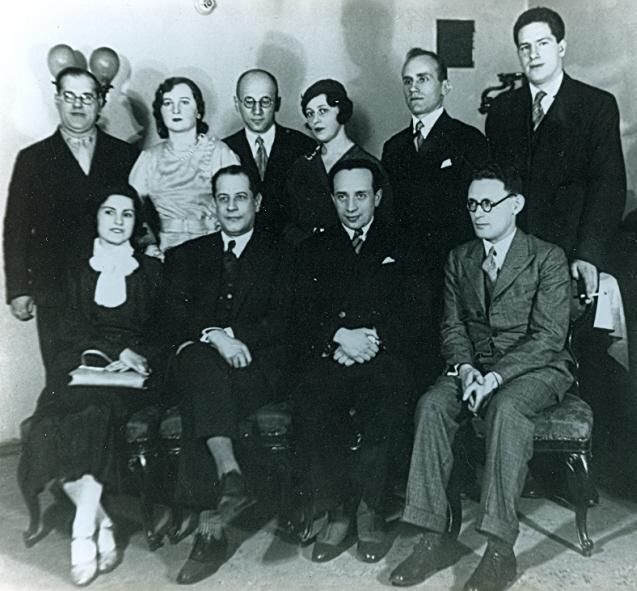
From Grzegorz Siwek (Warsaw):
‘Among the persons seated are, of course, Capablanca (second from the left) and Botvinnik (far right). Standing on the far right is Grigory Goldberg, who became Botvinnik’s second in his world championship matches in the 1950s. On his right is Jakov Rokhlin (Rochlin), and then comes Botvinnik’s wife Gayane and another chess writer, Samuil Weinstein (Vainstein).’
We now note that a second group photograph taken in the same room was published in the plates section of volume one of Botvinnik’s Best Games (Olomouc, 2000). Weinstein, Rokhlin, Capablanca, Botvinnik and Goldberg were identified in the caption, which also specified: ‘In the interval of ballet “Don-Kikhot”, Leningrad, 1933’. That cannot be correct since the Cuban’s first visit to the Soviet Union in the 1930s was not until 1935.
6187. Forced mate (C.N.s 6138 & 6145)
Vitaliy Yurchenko (Uhta, Komi, Russian Federation) supplies the text in the Russian edition of the monograph on Soldatenkov by V. Charushin (Omsk, 2000):
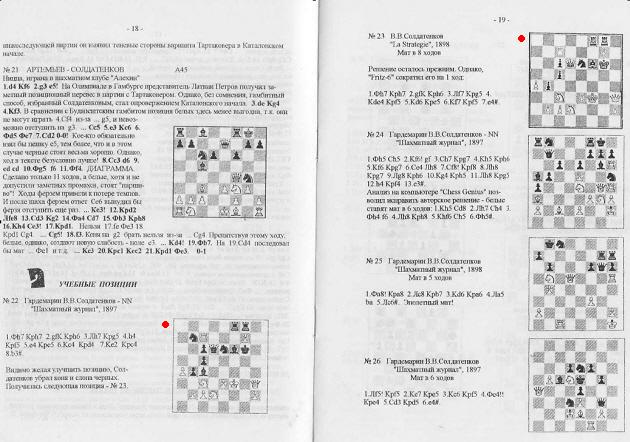
6188. Who? (C.N. 6174)

No reader identified this well-known figure: Julius du Mont. The photograph appeared on page 219 of CHESS, 28 April 1956, which carried his obituary.
6189. Bobby Fischer Uncensored
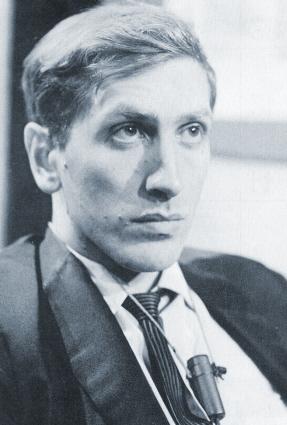
Bobby Fischer
One of the most extraordinary of all chess books has just been published: Bobby Fischer Uncensored by David and Alessandra DeLucia (Darien, 2009). A richly-illustrated 394-page hardback of supreme quality, it presents hundreds of items from David DeLucia’s collection of Fischer material, including photographs, game-scores, correspondence, contracts, books and ephemera.
For example, C.N. 4769 asked about the earliest known photographs of Fischer, and we note that page 11 has two which were taken in January 1953. A further shot on the same page shows ‘Bobby studying chess in the bath tub’.
Regarding the 1995 Batsford edition of My 60 Memorable Games there is much documentation, including (on pages 204-205) reproductions of Graham Burgess’s letter to Fischer dated 7 September 1994 announcing that Batsford planned a new edition (‘no new errors will be brought into the book’) and the reply from Fischer’s lawyer John Hazard (14 November 1994) stating that ‘Batsford Ltd. is mistaken in its assumption that it has the authority to publish a new edition of My Sixty Memorable Games’. The affair is also mentioned in detail in the extracts presented (on pages 248-261) from another item in Mr DeLucia’s collection, dated 18 November 1997: ‘a 100-page working typescript by Fischer entitled “What Can You Expect from Baby Mutilators”’.
Numerous illustrations are of books and other publications owned by Fischer, including such titles as The White Man’s Bible, The World Conspiracy and The Myth of the Six Million. His personal notebooks are also reproduced, and it would be impossible to overstate the anti-Semitism with which they are suffused. ‘Hitler was right about the Jews: They want to steal everything I’ve worked for all of my life’ (page 244). On page 285 another note, dated 21 May 1999, is also typical: ‘It’s time for programs against Jews and it’s also time for vigilante killings of Jews – random killings of Jews.’ Page 301 has a draft letter which begins:
‘Dear Mr Osama bin Laden allow me to introduce myself. I am Bobby Fischer, the World Chess Champion. First of all you should know that I share your hatred of ...’, etc., etc.
Mr DeLucia presents such material without editorial comment, rightly leaving readers to supply their own revulsion. Fortunately, though, the book contains much chess material too, such as (on page 82) photographic reproductions of ‘possibly four unrecorded games of Bobby’s from his 1964 US simul tour’.
Bobby Fischer Uncensored costs approximately $350-400, and we shall pass on to Mr DeLucia any messages from readers who wish to buy a copy.
6190. Mate in three (C.N. 6157)

This position was included in a quiz by H.E.G. Courtney on page 117 of CHESS, Christmas 1969 (‘it was published in the Chess Amateur during World War I, the composer’s name not being given’). The solution on page 126 of the same issue of CHESS was 1 bxc3 Ka3 or Ka1 2 O-O-O (i.e. 2 Kc1) Ka2 3 Ra4 mate, the trick being that White was giving the odds of his queen’s rook (see C.N. 6029). However, on page 133 of the January 1970 issue the composition was declared unsound: ‘The white king must have moved, otherwise the black king could not have got where it is. Dozens of readers have pointed this out. When the problem was published over 50 years ago, the blemish apparently went unnoticed.’
We have not yet found anything in the Chess Amateur.
6191. Man Ray and Alekhine
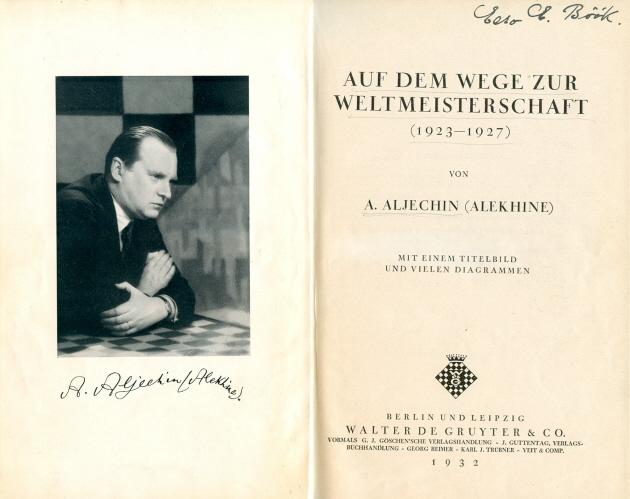
(Title page inscribed by Eero Böök)
The above photograph by Man Ray was also the frontispiece of Alekhine’s Chess Games, 1902-1946 by L. Skinner and R. Verhoeven (Jefferson, 1998).
A second shot was number 48 in Man Ray’s Paris Portraits: 1921-39 by Timothy Baum (Washington, 1989):
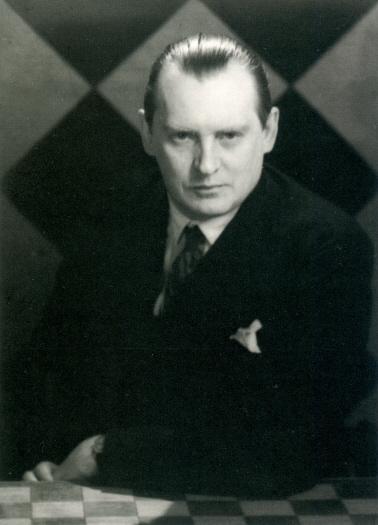
6192. The West Wing
Chess is frequently visible in television drama but seldom becomes a central theme. An exception is the episode ‘Hartsfield’s Landing’ in season three of the US series The West Wing, which even contained extensive discussion of the history of the game.
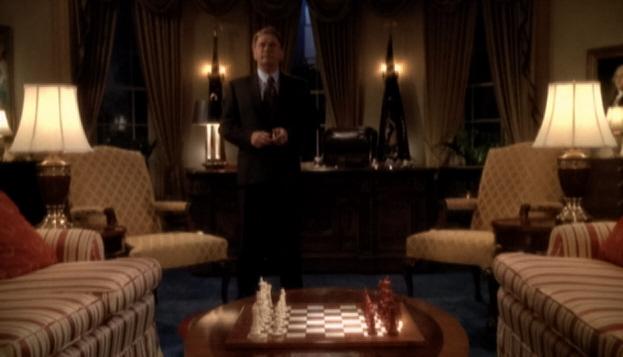
In the above freeze-frame President Bartlet (Martin
Sheen) is in the Oval Office with one of the chess sets
which he has brought back from India. During the episode
he plays games against two staff members, Sam Seaborn
(Rob Lowe) and Toby Ziegler (Richard Schiff), defeating
both.
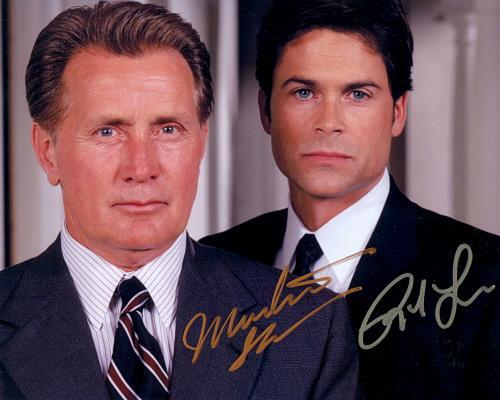
Martin Sheen and Rob Lowe
6193. Young Fischer (C.N. 6189)
We are grateful to David DeLucia (Darien, CT, USA) for permission to reproduce two photographs which, as mentioned in C.N. 6189, were taken in January 1953 and are on page 11 of his book Bobby Fischer Uncensored:
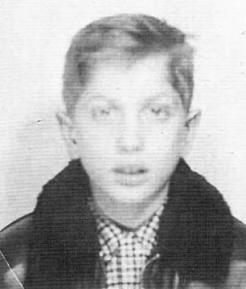
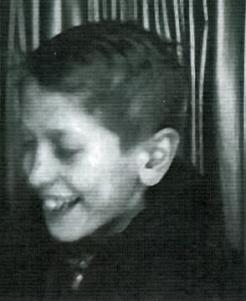
6194. Ciocaltea v Fischer
Frederick S. Rhine (Park Ridge, IL, USA) asks about an episode in the 1965 Capablanca Memorial tournament in Havana (for Fischer, in New York) related on page 213 of American Chess Masters from Morphy to Fischer by Arthur Bisguier and Andrew Soltis (New York, 1974):
‘All went well until Fischer played Viktor Ciocaltea of Rumania. Ciocaltea’s first move, 1 P-Q4, was played on the Marshall Club board by a FIDE judge. Fischer replied with his usual 1...N-KB3. Then came the remarkable reply, 2 P-K5!? There was considerable consternation on West 10th Street as the officials realized that White’s first move had been 1 P-K4 and not 1 P-Q4. Could Fischer take his move back? Could the error in transmission be explained? It didn’t matter because Fischer waved aside the fears by playing 2...N-Q4. He was willing to play Alekhine’s Defense, an opening he had never played before in tournament chess and was not to play again for five years. But he was sufficiently prepared to hold Ciocaltea to a draw in an unfamiliar opening.’
Do contemporary reports corroborate this account? We see nothing in Chess Life, Chess Review or the tournament book (published in Buenos Aires later in the year).
The game was played on 29 August 1965, and the following day the New York Times (page 22) noted that Fischer ...
‘... pulled two surprises yesterday in his third game of the Capablanca Memorial tourney: He adopted an unusual defense, and he discharged his referee.’
The report stated that Frank Brady, whose task was to oversee Fischer’s moves in New York, was dismissed ‘even before the game got under way’. His book on Fischer, Profile of a Prodigy, had been published the previous week.
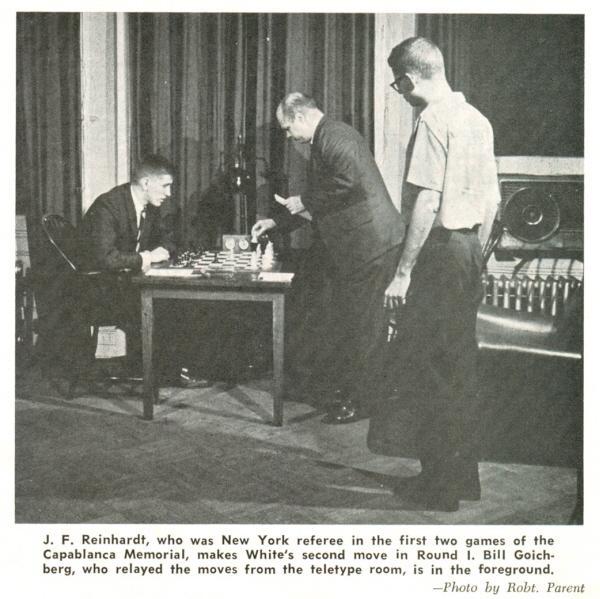
Source: Chess Life, September 1965, page 191
6195. Counter-counter-pin (C.N.s 6161 & 6183)
From Harold van der Heijden (Deventer, the Netherlands):
‘The Chéron study as in my database (with a white rook on a8) is the original setting published in the Journal de Genève of 23 February 1974, page 20. My own source was EG issue 37 (September 1974, page 128) with essentially the same story.
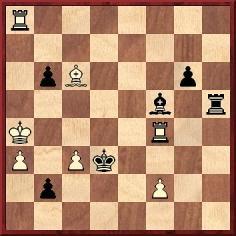
Key move: 1 Rb4
The original setting of the Troitzky/Korolkov study was cooked by 1...Kxc3 by K. Benson on page 557 of the October 1994 BCM. The correction (Black’s rook on h3 instead of h5) was proposed by me in the June 2004 issue of EBUR, page 11. Now 1...Kxc3 is elegantly refuted by 2 Rb3+ Kc2 3 Be4+ Bxe4 4 Rc8+ (with a black rook on h5 Black can play ...Rc5 here) 4...Kd1 5 Rxb2 with a technical win. After 1 Rb4 Rh4 2 c4 Kc3 3 Kb5 b1(Q) 4 Rxb1 Bxb1 5 Bd5 Black seems unable to stop Kxb6 and the quick advance of the white a-pawn.’
6196. Rudolf Hess and chess (C.N.s 6167 & 6173)
Lawrence Totaro (Las Vegas, NV, USA) notes that page 121 of Standing Up to the Madness by Amy Goodman and David Goodman (New York, 2008) reported:
‘“We got more information out of a German general with a game of chess or Ping-Pong than they do today, with their torture”, said Henry Kolm, 90, an MIT physicist who had been assigned to play chess in Germany with Hitler’s deputy, Rudolf Hess.’
Mr Totaro notes, however, that Kolm’s own ‘Military’ webpage referred to chess games against ‘Colonel Rudolf Hesse, a Prussian faculty member of the German War College and prime strategy advisor to Hitler’. Kolm added:
‘Hesse wanted to play chess every time I visited him in his cabin, and he was very talkative over the chess board. He usually won, and hated the few times he lost.’
Subsequently, Mr Totaro checked the matter with Kolm, who informed him:
‘Chess was simply a way to befriend German generals and get them to talk freely. I never played with Rudolf Hess, Hitler’s deputy ...’
| First column | << previous | Archives [59] | next >> | Current column |
Copyright: Edward Winter. All rights reserved.
